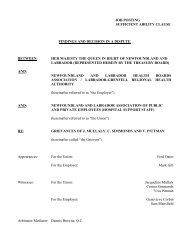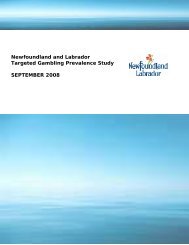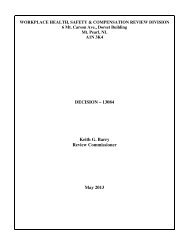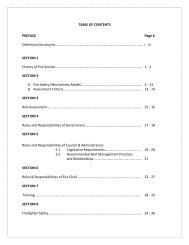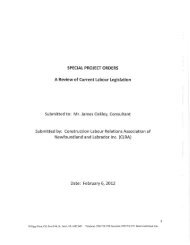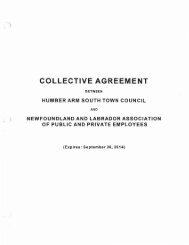Energy Plan - Government of Newfoundland and Labrador
Energy Plan - Government of Newfoundland and Labrador
Energy Plan - Government of Newfoundland and Labrador
Create successful ePaper yourself
Turn your PDF publications into a flip-book with our unique Google optimized e-Paper software.
In the event that the Lower Churchill Project does not proceed as anticipated,<br />
scrubbers <strong>and</strong> precipitators will be installed at the Holyrood facility. This will clean<br />
up many <strong>of</strong> the pollutants, however, it will not reduce the GHG emissions. As<br />
previously discussed in this Section, part <strong>of</strong> this alternate plan will be to increase<br />
the amount <strong>of</strong> wind <strong>and</strong> small hydro on the Isl<strong>and</strong> system. Natural gas conversion<br />
will also be assessed as a potential option if <strong>and</strong> when it is available.<br />
The earliest date for the full commercial delivery <strong>of</strong> Lower Churchill power is 2015<br />
<strong>and</strong> the earliest date for the scrubber <strong>and</strong> precipitator installation option would<br />
be 2013. Both options require the commitment <strong>of</strong> certain expenditures through<br />
the 2009 timeframe <strong>and</strong> <strong>Government</strong> will keep both options proceeding until<br />
the 2009 decision date for the Lower Churchill. In addition, NLH will continue<br />
to assess small hydro potential <strong>and</strong> wind opportunities on the Isl<strong>and</strong> system.<br />
Isolated Diesel Systems<br />
Communities that are not connected to the <strong>Labrador</strong> or Isl<strong>and</strong> power grids depend<br />
on small diesel-generating plants. Despite the substantial operating costs <strong>of</strong><br />
these systems, the cost <strong>of</strong> interconnecting them <strong>and</strong> developing renewable<br />
generation is typically still greater. Therefore, many isolated communities will<br />
continue to be served by diesel generation, as it is the most feasible <strong>and</strong><br />
cost-effective way to provide reliable electrical service. The costs <strong>of</strong> these<br />
isolated systems are currently being subsidized in the order <strong>of</strong> 75 per cent by<br />
other residential rate payers in the province. The Provincial <strong>Government</strong> has<br />
also recently provided an additional subsidy to residential customers in Coastal<br />
<strong>Labrador</strong> communities as part <strong>of</strong> the NSP for <strong>Labrador</strong>. This additional subsidy<br />
will make the effective rates that residential customers in these communities<br />
pay for basic customer service <strong>and</strong> the lifeline monthly block <strong>of</strong> electricity equal<br />
to <strong>Labrador</strong> Interconnected rates. Furthermore, the NSP committed to a review<br />
<strong>of</strong> commercial rates in these communities in conjunction with the sanctioning<br />
<strong>of</strong> the Lower Churchill project.<br />
POLICY<br />
ACTIONS<br />
Isolated Diesel Systems<br />
The <strong>Government</strong> <strong>of</strong><br />
<strong>Newfoundl<strong>and</strong></strong> <strong>and</strong> <strong>Labrador</strong> will:<br />
• Review commercial rates<br />
in <strong>Labrador</strong> coastal<br />
communities in conjunction<br />
with the sanctioning <strong>of</strong> the<br />
Lower Churchill project.<br />
• Work with the Aboriginal<br />
governments <strong>and</strong> groups to<br />
reduce the reliance on diesel<br />
energy in their communities<br />
where possible.<br />
• Continue to compare<br />
interconnection <strong>and</strong> diesel<br />
generation costs as operating<br />
costs change.<br />
• Support research <strong>and</strong><br />
development into wind <strong>and</strong>/<br />
or wind/hydrogen integration<br />
for isolated communities.<br />
In time, when the cost <strong>of</strong> connecting a community to the electricity grid becomes<br />
less than maintaining its isolated diesel system, these communities will be<br />
connected. This was done in Rencontre East in 2006, <strong>and</strong> previously in such<br />
communities as Burgeo, St. Anthony, Fogo-Change Isl<strong>and</strong>s, Petite Forte, Gr<strong>and</strong><br />
Bruit <strong>and</strong> others.<br />
Although diesel generation is the least expensive method <strong>of</strong> supplying electricity<br />
to isolated consumers, it is still costly. In terms <strong>of</strong> energy use, it is also<br />
inefficient. Space heating with an oil-fired furnace, for example, is more than<br />
twice as efficient as burning diesel fuel for power generation for electric heating.<br />
The Provincial <strong>Government</strong>’s Home Heating Rebate program helps to <strong>of</strong>fset the<br />
cost <strong>of</strong> heating, however, conservation measures could have an additional benefit<br />
to customers whose heating bills are high. The Provincial <strong>Government</strong>’s renewed<br />
efforts in energy efficiency <strong>and</strong> conservation programs will help in this regard. An<br />
innovative technology that may allow NLH to reduce the use <strong>of</strong> diesel-generated<br />
electricity in remote communities is combining wind power <strong>and</strong> hydrogen. This<br />
is currently undergoing research <strong>and</strong> development in Ramea <strong>and</strong> is discussed<br />
in more detail in Section 6 – <strong>Energy</strong> <strong>and</strong> the Economy.<br />
39



